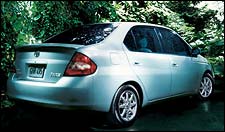Hybrid vigor has long been a trusted tenet of biology: Cross a shiny red tomato with a frost-resistant tomato, and chances are you’ll get a superior offspring that’s both beautiful and cold hardy. A similar idea gave rise to the auto industry’s new breed of hybrid cars– they combine the fueling convenience of gas-powered cars with the energy efficiency of electric batteries, adding up to something that beats all other vehicles on the market in terms of great gas mileage and low emissions. For instance, hybrid vehicles can travel up to 700 miles– roughly the distance from Seattle to San Francisco– on a single tank of gas. According to the Union of Concerned Scientists, the hybrid reduces smog-forming emissions (namely, nitrogen oxide and particulate matter) by 90 percent.
 2003 Toyota Prius, Courtesy Toyota
2003 Toyota Prius, Courtesy Toyota
The culmination of years of research in the race for the ultimate in fuel efficiency, the hybrid is a not-so-mean green machine– basically a gasoline-driven cross between a common internal combustion engine and a battery. The battery kicks in at idle speeds making stop-and-go city driving ultra-efficient, and on long stretches of highway, the battery automatically takes charge while coasting.
Unlike a full-electric vehicle, the hybrid’s battery is self-contained and recharges while tapping the brakes, thus requiring no plug-in. “Battery technology alone didn’t progress as environmentalists had hoped,” says Kliesch. Although the goal of zero tailpipe emissions had been met, electric cars were expensive, and did not have the range to drive significant distances without a long sojourn to recharge.
But the fuel system isn’t the only aspect of hybrid cars worthy of a green star. While their designs tend to look like something on Frank Gehry’s sketch pad, these cars are extremely aerodynamic– upping the fuel-efficient ante. Plus, the material used to build cars such as the Honda Insight and Toyota Prius is lightweight, high-strength aluminum alloy. The combination of a sleek shape, low weight and energy efficient engine works like lean Lance Armstrong climbing the Alpe d’Huez.
While Japanese auto makers are leading the pack in marketable hybrid technology, U.S. car companies are also catching green fever. Ford, GM and DaimlerChrysler have all created hybrids slated to debut in the next five years. And there’s good news for four-wheel drive fanatics: The hybrid engine can also effectively be implemented in S.U.V’s.
Joanne Shore, a senior analyst for the DOE’s Energy Information Administration, classifies hybrids as “advanced technology vehicles” because of their low pollution-output and potential to displace a significant need for foreign oil. For the last two decades, the US has been responsible for one-quarter of the world’s oil use, according to the DOE. Passenger vehicles typically account for more than 40 percent of that oil, swallowing more than 336,000 million gallons per day. Without an expensive facelift to America’s fuel-station infrastructure, the hybrid is the most viable option for minimizing gas consumption and vehicle pollution, according to Kliesch. It’s a technology marriage environmentalists have been clamoring for, and even though the hybrid’s innate virtues sell themselves, the government offers additional incentive—a $2000 tax deduction for purchasing one.
So what would Kliesch drive? “No question,” he says. “The greenest vehicle out there is the hybrid.”
Want to find out more? Check out our green fuel guide:


